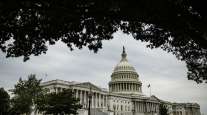Trump Pushing Hard to Reach NAFTA Agreement

With critical political deadlines fast approaching, the Trump administration is racing to strike a deal on a revamped North American Free Trade Agreement by early May — with an eye toward forcing a congressional vote on a new pact by the end of the year.
After months of making little progress, recent statements from high-level trade officials meeting in Washington indicate that negotiations have been gaining momentum and that there’s a fair chance of reaching an agreement in principle in weeks or even days.
But as Trump’s chief trade negotiator, Robert Lighthizer, resumed talks April 24 with his Canadian and Mexican counterparts, analysts say the three sides have yet to close the gap on several key issues, leaving many wondering whether there’s enough time. Canada and Mexico, rather than make politically unpopular concessions, may decide it’s better to prolong the talks, even at the risk of a U.S. withdrawal from NAFTA, as Trump has repeatedly threatened.
RELATED: Trump push for quick NAFTA deal slowed by division on top issues
Moreover, Trump’s practice of lumping different issues together for bargaining leverage has increased uncertainties about the fate of negotiations. Last month, Trump gave an exemption to Canada and Mexico on hefty steel and aluminum tariffs, but only until May 1, saying what happens afterward would depend on how rewriting NAFTA comes along.
And on April 23, Trump suggested that a NAFTA overhaul should include another one of his goals, tighter control of people entering from the southern border. “Mexico, whose laws on immigration are very tough, must stop people from going through Mexico and into the U.S.,” the president said on Twitter. “We may make this a condition of the new NAFTA Agreement.”
The Trump administration has good political reason to wrap up NAFTA talks in the coming weeks. It wants to lock in a deal ahead of Mexico’s presidential election on July 1. Trump and his Republican backers also have their sights on the U.S. midterm elections. A successful conclusion to NAFTA talks could give a lift to the GOP and soften an expected loss of seats and possibly control of the House.
RELATED: Mexico’s NAFTA negotiator optimistic for deal by early May

Ildefonso Guajardo Villarreal, Mexico's secretary of economy, from left, Chrystia Freeland, Canada's minister of foreign affairs, and Bob Lighthizer, U.S. trade representative, arrive for a meeting during third round negotiations of NAFTA. (David Kawai/Bloomberg News)
To meet that goal under congressional trade rules, Lighthizer would need to reach an agreement in principle in a matter of days to have a realistic chance for lawmakers to pass it in December. That is because the parties need time to write a text, give a mandated 90-day notice to Congress and have an economic impact report completed before Congress can vote it up or down. Trump is betting that his best shot for approval would come during the lame-duck session, when many lawmakers may be willing to take more difficult votes.
As part of the administration’s legislative strategy, Trump could give the required six months’ notice of withdrawal from NAFTA about the time a text is ready, essentially forcing Congress to accept the new accord or risk the end of the 24-year-old pact, according to trade experts.
“The status quo, which most members of Congress probably prefer, would not be an option,” wrote William Reinsch, a senior advisor at the Center for Strategic and International Studies, although he questioned the wisdom of employing such hardball tactics.
Such a move could inflame lawmakers. Nor is it clear whether Trump has the legal authority to pull out of NAFTA without congressional support. And many on Capitol Hill and Wall Street fear the potential political and economic fallout of termination. An end to NAFTA would cause tariffs to rise and create other barriers that would almost certainly hurt trade, production and investments throughout North America.
Settling the NAFTA talks would also allow the Trump administration to focus on another, more-fraught trade front with America’s biggest trading partner, China.
Already the tight political calendar has spurred Lighthizer to soften his demands to overhaul NAFTA rules on cars to increase auto and parts production in the United States.
Lighthizer dropped his initial push for a new 50% minimum of U.S.-local content before a vehicle can get NAFTA’s tariff-free treatment, and instead is looking at a different formula that could provide more work for American facilities. He has also shown a willingness to bend somewhat on his original proposal to raise the overall North American portion of the value of vehicles to 85% from the current 62.5%, meant largely to reduce reliance of parts from Asia in the assembly of cars and trucks.
But at the same time, Lighthizer has given little indication that he will make a broad retreat on major negotiating objectives, including eliminating or weakening certain NAFTA dispute-resolution mechanisms, revising government procurement rules in favor of American firms, and inserting a new, so-called sunset provision that would allow the U.S. to reopen NAFTA after a period of time.
Trump has repeatedly blasted NAFTA as a bad deal for America, blaming it for destroying domestic jobs and factories. But many economists point to factors such as automation for displacing U.S. workers and doubt that a revamped NAFTA would lead to a big renaissance in manufacturing jobs.
Distributed by Tribune Content Agency, LLC




